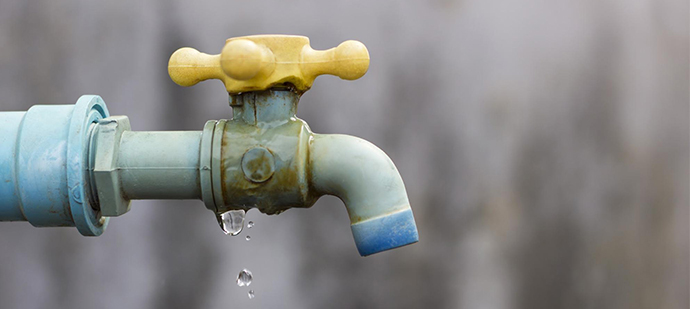Detect Concealed Water Line Leaks: Six Smart Detection Tips
Detect Concealed Water Line Leaks: Six Smart Detection Tips
Blog Article
We've encountered this great article on Leaking water lines down the page on the web and felt it made good sense to share it with you on my blog.

Early detection of dripping water lines can minimize a potential disaster. Some small water leaks might not be noticeable.
1. Check Out the Water Meter
Every house has a water meter. Inspecting it is a guaranteed manner in which aids you discover leakages. For starters, turn off all the water sources. Guarantee nobody will certainly purge, make use of the tap, shower, run the cleaning equipment or dishwasher. From there, go to the meter and watch if it will change. Because nobody is using it, there must be no activities. If it relocates, that indicates a fast-moving leak. Similarly, if you identify no changes, wait an hour or two and also examine back once more. This implies you may have a slow-moving leakage that can even be underground.
2. Inspect Water Usage
If you detect sudden changes, regardless of your usage being the same, it suggests that you have leaks in your plumbing system. An abrupt spike in your expense indicates a fast-moving leakage.
A stable rise every month, even with the very same practices, reveals you have a slow-moving leak that's additionally slowly escalating. Call a plumber to extensively inspect your home, especially if you really feel a warm location on your floor with piping underneath.
3. Do a Food Coloring Examination
30% comes from bathrooms when it comes to water intake. Test to see if they are running effectively. Decrease flecks of food color in the container as well as wait 10 mins. There's a leak in between the tank and also bowl if the shade somehow infiltrates your bowl during that time without flushing.
4. Asses Outside Lines
Do not neglect to check your exterior water lines too. Needs to water seep out of the link, you have a loose rubber gasket. One tiny leak can waste lots of water as well as surge your water expense.
5. Check as well as Evaluate the Circumstance
Property owners ought to make it a practice to check under the sink counters and even inside closets for any kind of bad odor or mold and mildew growth. These two red flags show a leakage so timely interest is required. Doing regular examinations, also bi-annually, can save you from a major problem.
If you understand your house is already old, maintain a watchful eye on your heaters, tubes, pipelines etc. Look for stainings and weakening as the majority of home appliances and pipelines have a life span. They will additionally naturally deteriorate as a result of deterioration. Don't wait for it to escalate if you believe dripping water lines in your plumbing system. Call an expert plumber immediately so you do not end up with a dreadful mess in your house.
Early detection of dripping water lines can alleviate a possible disaster. Some tiny water leakages might not be visible. Examining it is a guaranteed means that helps you find leakages. One small leakage can lose lots of water and also surge your water costs.
If you think dripping water lines in your plumbing system, do not wait for it to escalate.
How to Know If Your Home Has a Hidden Leak
Water Meter Reveals Inexplicable Water Usage
If you’d like to test whether or not there’s a leak somewhere in your home, you can do this using your water meter. Here is how to conduct the test:
Don’t use any water in your home for at least 30 minutes; this also means not turning on faucets or water-using appliances.
Go outside, and check your water meter for activity.
If your water meter shows that there was activity, even though no one was using any water, this proves that there is a leak in your home.Visible Mold or Mildew Growth
Leaks behind walls create moist, dark environments that allow mold and mildew to grow and thrive. Eventually, you might see mold growth forming on the wall closest to a hidden leak.
If mold is growing in an area that receives a high amount of moisture, such as a bathroom, it may simply be an indication that better ventilation is needed. However, if you see mold growth on a wall or the ceiling in an area where you would not expect, you probably have a hidden leak.
Musty, Mildew Odor
Sometimes you might not be able to see the mold or mildew that is growing as a result of a leak. However, the smell can give the problem away just as easily. If you catch a whiff of something musty, there’s a good chance that old water is collecting somewhere in your home that you can’t see.
Stained/Warped Walls, Ceilings, or Floors
When your home soaks up water, a variety of red flags can become visible, including ceiling stains, bubbling drywall, warped walls, and sagging floors. While these issues can be caused by excess humidity, they can also be signs that a pipe or plumbing connection has started leaking behind your walls.
Inexplicably High Water Bill
After a while, you get a general sense for what your water bill should be. If you own a pool or sprinkler system, your bill will tend to be higher during summer. However, if you receive a water bill that seems especially high, and you can’t figure out what caused it, then you may have a hidden leak somewhere that’s increasing your bill.
https://www.plumbingjoint.com/blog/2019/july/how-to-know-if-your-home-has-a-hidden-leak/

We were guided to that article on Hacks to detect leaks from an associate on another site. Those who enjoyed our blog posting plz do not forget to share it. Thanks a bunch for your time. Don't hesitate to pay a visit to our website back soon.
See Availability Report this page